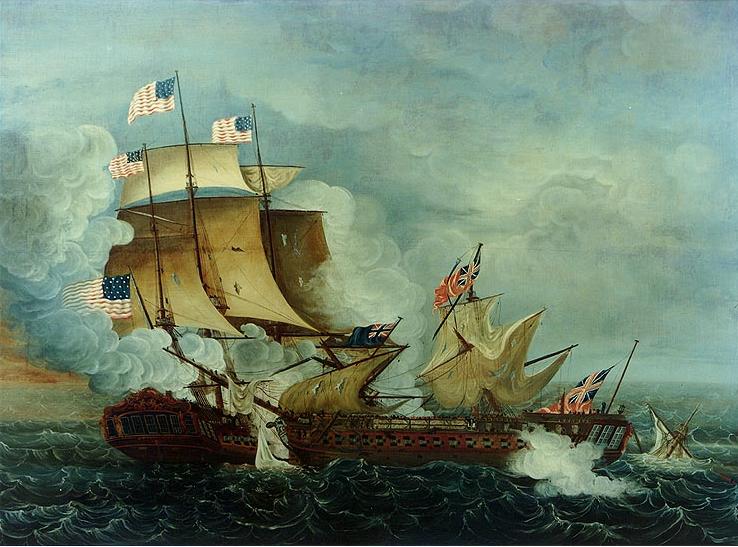
196 years ago this Tuesday last ....
“Ay, tear her tattered ensign down!Today is the 196th anniversary of the defeat of the British frigate, HMS Guerriere, by her American counterpart, USS Constitution, "Old Ironsides" - on 19 August 1812, perhaps the most famous naval encounter of the War of 1812. What a battle it was.
Long has it waved on high,
And many an eye has danced to see
That banner in the sky;
Beneath it rung the battle shout,
And burst the cannon's roar;
The meteor of the ocean air
Shall sweep the clouds no more.
Her deck, once red with heroes' blood,
Where knelt the vanquished foe,
When winds were hurrying o'er the flood,
And waves were white below,
No more shall feel the victor's tread,
Or know the conquered knee;
The harpies of the shore shall pluck
The eagle of the sea!
Oh, better that her shattered bulk
Should sink beneath the wave;
Her thunders shook the mighty deep,
And there should be her grave;
Nail to the mast her holy flag,
Set every threadbare sail,
And give her to the god of storms,
The lightning and the gale!”
- - Oliver Wendell Holmes
("Old Ironsides")
The U.S. Frigate Constitution left Boston, Massachusetts, on 2 August 1812, bound for a raiding cruise off Nova Scotia, the Gulf of St. Lawrence and Newfoundland. Her Commanding Officer, Isaac Hull, was eager to find and fight one of the several Royal Navy frigates then active off North America, and on 18 August an American privateer informed him that one might be found further south. The next afternoon, some 400 miles southeast of the British base at Halifax, a sail was sighted that turned out to be HMS Guerriere, one of the frigates that had fruitlessly pursued Constitution off New York a month earlier.The below summary is going around, I'll copy it in whole.
Guerriere's Captain, James R. Dacres, was also spoiling for a fight. Despite his ship's disadvantages in number and size of guns, and number of crewmen, the long British tradition of victory in ship-to-ship combat against European enemies provided reasonable grounds for Dacres' aggressive optimism. As Constitution approached on this windy, cloudy day, Guerriere began firing alternating broadsides that produced few hits and little damage. Constitution's return fire, limited to a few guns mounted forward, was also ineffective, but this changed markedly as the two ships drew alongside at about six in the evening of 19 August 1812.
A quarter-hour of intense gunnery by Constitution, delivered with much superior accuracy, battered Guerriere in the hull and masts. The British frigate's mizzenmast fell over the side, crippling her ability to maneuver. Constitution then moved ahead to rake Guerriere, whose bowsprit caught in the American's mizzen rigging. Firing continued while the two ships were thus tangled, and both sides prepared boarding parties. Marksmen in the mast tops blazed away at exposed personnel, with deadly effect. Many officers and men were thus killed, including Constitution's Marine lieutenant. Others, Captain Dacres among them, were wounded. As the ships separated, Guerriere's foremast collapsed, pulling down the mainmast with it. She was now a "defenseless hulk", and surrendered at 7 PM, when Constitution approached to renew the action after making brief repairs to her modest damages. British casualties were more than five times those of the Americans, and Guerriere was beyond saving. Her surviving crewmen were taken off the next day, she was set afire and soon blew up. Constitition then returned to Boston with her prisoners, arriving on 30 August.
This battle, the first of several U.S. Navy victories in ship-to-ship contests, encouraged Americans and chagrined the British. Despite the rational excuse that Royal Navy frigates were not as large and powerful as their American counterparts, the real causes of these outcomes were inspired seamanship and vastly better gunnery. For the rest of the 19th Century, long after the War of 1812 was over, America's Navy was credited with an effectiveness that went well beyond its usually modest size.
Designed by naval architect Joshua Humphreys and laid down in Boston in 1794, Constitution was one of six frigates authorized by Congress during the presidency of George Washington to meet the threat of both "Barbary pirates" and British belligerence. Launched in 1797, she saw earlier service in the West Indies and the Mediterranean and subsequently continued sporadically on active duty until 1855, when she was converted to a training ship. Still considered a commissioned warship of the U.S. Navy, Constitution is maintained today as a historic vessel in the city where she was built.And she is still with us. Thanks Oliver!
American poet Oliver Wendell Holmes (1809-1894) wrote "Old Ironsides" in 1830, when the Navy considered scrapping the ship - then laid up in Boston - as an economy measure. Holmes' verse stirred up such a public outcry that the Navy soon agreed to refurbish Constitution in 1833, and as noted, she's still with us today.
Hat tip Byron.
No comments:
Post a Comment